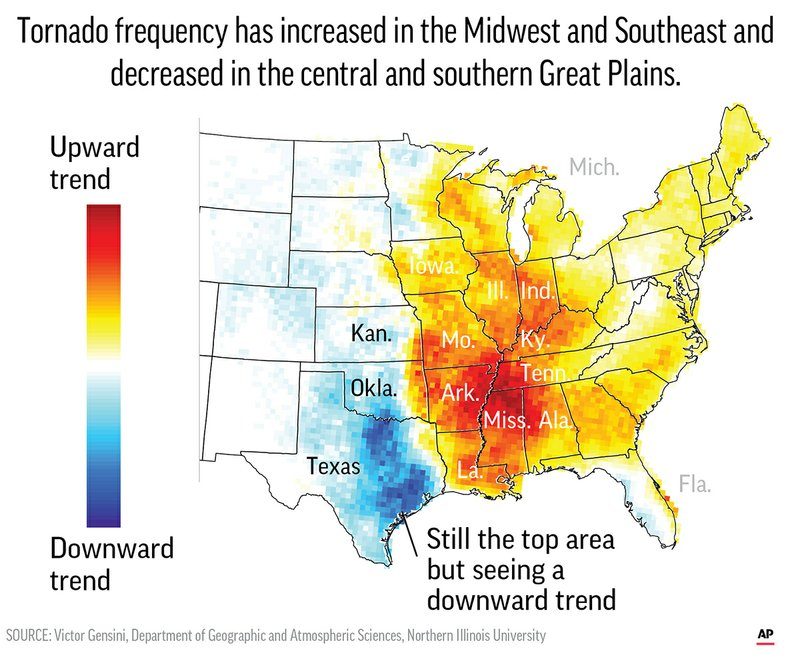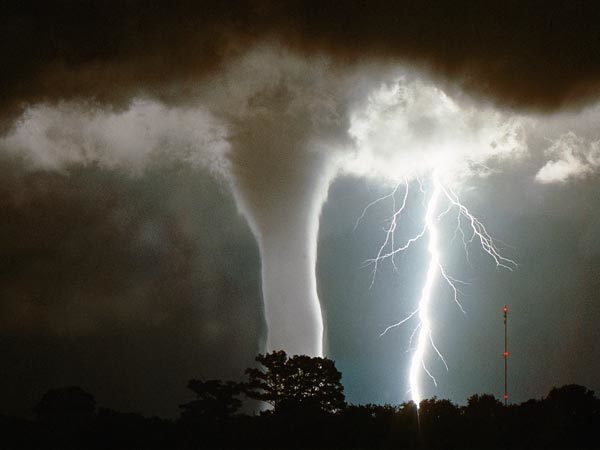
© NatureThe US tornado Alley shifts to the East.
Over the past few decades tornadoes have been shifting - decreasing in Oklahoma, Texas and Kansas but spinning up more in states along the Mississippi River and farther east. But scientists aren't quite certain why.
Tornado activity is increasing most in Mississippi, Arkansas, Tennessee, Louisiana, Alabama, Kentucky, Missouri, Illinois, Indiana, Wisconsin, Iowa and parts of Ohio and Michigan. There has been a slight decrease in the Great Plains, with the biggest drop in central and eastern Texas. Even with the decline, Texas still gets the most tornadoes of any state.
The shift could be deadly because
the area with increasing tornado activity is bigger and home to more people. Also more people live in vulnerable mobile homes and tornadoes are more likely to happen at night in those places.
Even though Texas, Kansas and Oklahoma get many more tornadoes, the four deadliest states for tornadoes are Alabama, Missouri, Tennessee and Arkansas. More folks are generally at risk because of that eastward shift.
Because tornadoes sometimes go undercounted, especially in the past and in less populous areas, scientists don't like to study trends by using counts of tornadoes. Now
scientists prefer to focus on differences between wind speed and direction at different altitudes, how unstable the air is and humidity. The more of those three ingredients, the more likely tornadoes will form.
The study looked at changes since 1979. Everywhere east of the Mississippi, except the west coast of Florida, is seeing some increase in tornado activity. The biggest increase occurred in states bordering the Mississippi River.Why is this happening?
We don't know. But here's my guess: As the Great Plains dry out, there's less moisture to have the type of storms that spawn tornadoes. Tornadoes form along the "dry line" where there are more thunderstorms because there's dry air to the west and moist air from the Gulf of Mexico to the east. That dry line is moving east.
By the way, you can support your Strange Sounds by becoming a Patron on Patreon or donating through Paypal. Please and thank you.
Nature - Spatial trends in United States tornado frequency
NOAA - Tornado fatalities per US States
WREG - Tornado activity increasing in Mid-South and scientists don't know why
Comment: The model of cyclonic activity based solely on heat and moisture is outdated, and the likely explanation relates to our
quieting sun, increased
meteor dust, and the
changing behaviour of electro-magnetism on our planet.
In the book
Earth Changes and the Human-Cosmic Connection Pierre Lescaudron and Laura Knight-Jadcyzk explain this in greater detail:
The accumulation of cometary dust in the Earth's atmosphere plays an important role in the increase of tornadoes, cyclones, hurricanes and their associated rainfalls, snowfalls and lightning. To understand this mechanism we must first take into account the electric nature of hurricanes, tornadoes and cyclones, which are actually manifestations of the same electric phenomenon at different scales or levels of power. Because of this similarity, we will refer to these three phenomena collectively as 'air spirals' in the following discussion.
McCanney describes the electric nature of hurricanes in these terms:
A simple model showed that these [tropical] storms formed when electrical currents connected between the ionosphere and the top of the clouds. [...] the reason hurricanes lost power when they approached land was that the powering electrical current from the ionosphere to the cloud tops and to the Earth's surface had no connection (anode) while over the ocean [...] so it drew up vast surface areas of ionized air from the ocean surface and sucked them up a central column (the spinning vortex was caused by the moist air rising 'up the drain') [...] whereas the land provided a 'ground' for the current and therefore it shunted out the storm's power source. [...] I also calculated that the warm water theory for hurricane development lacked sufficient energy to account for the energy in these massive storms. We later witnessed hurricanes on Mars where there is no water at all. Clearly, the warm water concept did not work [...]1

© Fred K. Smith, National Geographic.A waterspout parallels a lightning strike over Lake Okeechobee in Florida.
And check out the companion podcast:
Behind the Headlines: Earth changes in an electric universe: Is climate change really man-made?See also:




Comment: The model of cyclonic activity based solely on heat and moisture is outdated, and the likely explanation relates to our quieting sun, increased meteor dust, and the changing behaviour of electro-magnetism on our planet.
In the book Earth Changes and the Human-Cosmic Connection Pierre Lescaudron and Laura Knight-Jadcyzk explain this in greater detail: And check out the companion podcast: Behind the Headlines: Earth changes in an electric universe: Is climate change really man-made?
See also: